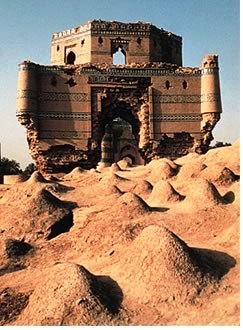Of the seven large villages, constituting the present (1878 A.D.), Uchch, that in witch the tomb and shrine of the Sayyid, Jalal-ud-Din, Husain, Bukhari, is situated, is call Uchch-i-Sharif, and Uchch-i-Jalali; and that in which is the tomb and shrine of the famous Makhdum-i-Jahan-gasht is known as Uchch-i-Makhdum. The village in which the governors on the part of the Badshahs of Dihli dwelt is named Uchch-i-Mughal, and so on, all seven places having separate names, but the rest are quite local.
The rivers Hariari or Gharah, the Chin-ab, and the Sindh, unite above six kuroh to the north of Uchch, and the combined waters are known under the name of Sindh or Ab-i-Sindh, which, flowing through the country of Sindh, finally reaches the salt sea. The ancient name was Mihran.
 These seven villages constituting the present Uchch are in the possession of the Sayyidâs descendants and those of Shaikhs, and they hold them rent free, and have no taxes whatsoever to pay. The are under allegiance to Timur Shah, Sadozi Durrani, Badshah of Kabul, as are, likewise, the rulers of Sindh, and the chief of Bahawalpur, who is a Daud-putrah.
These seven villages constituting the present Uchch are in the possession of the Sayyidâs descendants and those of Shaikhs, and they hold them rent free, and have no taxes whatsoever to pay. The are under allegiance to Timur Shah, Sadozi Durrani, Badshah of Kabul, as are, likewise, the rulers of Sindh, and the chief of Bahawalpur, who is a Daud-putrah.
At the present time Uchch consists of but three small towns, the principal ones named above, which stand on high artificial mounds, the neighborhood having been at all times liable to be wept away by the Indus, which, as related by the writer of the above account, in his time, as in former years, flowed much near to Uchch than it does at present. Such an inundation threatened to destroy it in the time of the Khwajah, Yahya-i-Kabir, the Bakht-yar Afghan saint, at the time he was the disciple of the Sayyid, Jalal-ud-Din, Husain, Uchchâs greatest saint. These three places are contiguous to each other, and are connected by a wall of brick, in a dilapidated state.
All round the place vast ruins of the former city and fortifications lie scattered about, and testify to the solidity of the buildings. They are constructed of burnt bricks, like all the solid structures of these parts, where stone is not procurable; and some of the buildings, even in these days, are in a good state of preservation.
During the latter years of the Lati or Kalhorah power in Sindh, and the rise of the chiefs of Bahawalpur, shortly before the time these surveys were made, there used to be constant hostility between the Makhdums of Uchch and the Daud-putrah chiefs, but, subsequently, they made up their differences.
Uchch is a place of considerable antiquity. As early as the time of Sahi, ruler of Sindh, son of Sihras Rae, who was killed in battle with the Arabs, Uchch was one of the principal fortified cities of Sindh, the strength of which Sahi increasedâaccording to the Sindhi annalsâ by raising the height of the mounds on which they stood.
In after times, when Sindh and Multan formed separate Muhammadan provinces, and were subject to Ghaznin and afterwards to Dihli, also when Sindh formed an independent state under sultan Nasir-ud-Din , Kaba-jah, and likewise after the invasion of Hind by Amir Timur, the Gurgan, Uchch was not included in Sindh, but formed an integral part of the Multan Province.
Sultan Ghiyas-ud-Din, Muhammad, son of Sam, the Shansabani Tajzik ruler of the Ghurian empire, in (1173-74 A.D.), with some difficulty, expelled the Ghuzz Turks from Ghaznin and its dependencies, after they had been twelve years in possession, after which he conferred the sovereignty over that State upon his brother, Muizz-ud-Din, Muhammad, who had previously been in possession of Tigin-abad and its dependencies. This sultan, in (1178-79 A.D.), some say in the following year, possessed himself of Uchch, when on his way against Nahrwalah of Gujerat.
At this time Uchch was in the possession of a chief of the Bhati tribe of the Jats, and in the tracts around, and as far east as Bhatindah, they are still located.
The feudatory of Uchch, Malik Nasir-ud-Din, Aetamur (having been killed in the battle with the forces of Khita and the Maliks of Turkistan near Indakhud, also called Andkhud, in (1204-5 A.D.), in which Sultan Muiz-ud-Din, Muhammad-i-Sam, was defeated, he, on his return to Ghaznin, conferred the fief of Uchch upon another of his slaves, Malik Nasir-ud-Din, Kaba-jah. He was I-bakâs son-in-law, and, as before stated, I-bak was the son-in-law of I-yal-duz, for the Sultan promoted these matrimonial connections among his mamluks.
After the sudden death of Sultan Kutb-ud-Din, I-bak, at Lahore, from an accident he met with, whilst playing at Chaugan, Kaba-jah assumed independence and the title of Sultan at Uchch, and possessed himself of Multan, Sindh-u-stan and Dibal, and their dependencies, as for as the sea coast, and brought all Sindh, as well as the country east of the Wahind or Hakra, as far as the limits of Tabarhindah, Kuhram, and Sursuti, under his sway. He was ousted from Multan and Uchch on one occasion by Sultan Taj-ud-Din, I-yal-duz, who, for a time held possession of Lohor, but, after the latterâs defeat, imprisonment, and death, at the hands of Shams-ud-Din, I-yal-timish, the slave, son-in-law, and successor of Sultan Kutb-ud-Din, I-bak, after the short reign of Sultan Aram Shah,, who was the adopted son of I-bak , but who is, by some historians, call his son, Kaba-jah received those cities and their dependencies once more.
